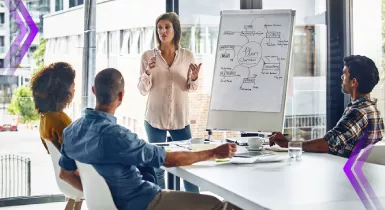Organizational processes and functions have transformed and evolved with the advent of modern technology. One of the most significant changes the business industry has experienced is replacing legacy tools with advanced and intuitive solutions. It has not only streamlined the resource and project management processes but has also brought the siloed departments and teams into one place.
Taking project resource management into account, it is a systematic flow of several steps, starting from planning and scheduling to executing and ensuring successful project delivery. A critical step amongst these is the request for resources. While the resource schedules and project plans are well-formulated and recorded, resource requesting is often unstructured at firms.
Now that organizations are matrixed and foster a shared-services model, forming a resource requisition workflow is imperative to avoid internal conflicts and discrepancies.
This article emphasizes the basic concepts and significance of process-driven resource requisition and some tips for implementing it efficiently.
Beginning with the definition,
Definition of resource request
Resource request is a formal procedure that a project manager follows to request and procure resources for an open position. This process typically involves defining the quantity, type, and quality of resources needed for the project.
Before drawing out a project plan, the project manager assesses the resource requirement to execute every project task. To fulfill this project resource demand, the project manager will request resource managers to allocate the right resource to the open position. This process of placing a formal request to fill the project vacancies before the initiation date is known as resource request.
However, if managers follow the traditional method, they will get stuck in the endless loop of emails and phone calls. The project manager sends an email to the resource manager, who will then go to various departmental heads, team leaders, and so on. By the time they find the right resource, the opportunity is lost.
To ensure that your project demands are fulfilled on time, it is essential that you invest in a reliable resource management tool. It will provide you with a bird’s eye view of the enterprise-wide workforce and their schedules and help you reap the benefits of a systematic project-staffing process. And that’s how to request company resources for a project.

Let us now see how resource requisition benefits the firm,
Benefits of efficient resource request process
Integrating an automated resource requisition and approval workflow in your management system can provide a myriad of benefits. Here is a brief description of each one of these:
- Facilitates efficient resource planning
With a proper resource requisition framework, managers can place a request well in advance. This gives managers sufficient lead time to identify, forecast and allocate the best-fit resources to fulfill the demand. In situations where the required resources are unavailable or occupied, and the talent pool is in-equipped to handle the project, managers can take appropriate resourcing measures to bridge the gap. They can either hire a new employee, upskill the existing talent pool or deploy a benched resource to the task/project. This enhances the overall efficiency of project resource planning.
Read More: The Art of Resource Planning Across Multiple Projects
- Avoids internal conflicts
Often, multiple projects with competing priorities may require the same resources at the same time, which can lead to confusion, conflict of interest and chaos. However, this can be avoided if the firm follows a structured approach to resource requisition. When a project manager raises a request, the resource manager will be able to seamlessly identify and assign the required resources based on the project’s priority and availability. This systematic approach helps eliminate disapproval or conflicts between the project managers and ensures timely project initiation and completion.
- Eliminates double bookings
When an organization has a well-defined resource-requesting process and centralized visibility into resources’ current and future schedules, it helps break down information silos. With this enhanced transparency, managers are able to monitor and track resource availability and bookings in real time. This insight allows firms to proactively assign resources based on their available capacity to project tasks, thus eliminating instances of double-booking, and preventing over-allocation.
- Aids competent resource allocation
When a project is in the opportunity pipeline, resource managers equipped with a multi-dimensional resource scheduler can track various dimensions, such as the workforce’s skill sets, competencies, team, department, location, availability, capacity, etc. This gives managers enough time to overcome resource-related bottlenecks, thus ensuring they have the right resources during the requisition process. Finally, by aligning suitable employees to the right projects, firms can ensure competent resource allocation.
Read More: Resource Allocation: A Guide on How to Apply it to Project Management
- Improves resource utilization and ROI
Next, managers consistently track resource utilization levels to ascertain the optimal usage of the talent pool. In case of discrepancies, i.e., sub-optimal resource utilization, managers can apply appropriate optimization techniques to ensure balanced work distribution. For instance, when resources are overutilized, managers can adjust project timelines or deploy additional resources to share the workload. In cases of resource underutilization, firms can mobilize personnel from non-billable to suitable strategic/billable projects. This helps improve the workforce’s health index and maximize the firm’s ROI.
- Maintains a request and approval audit trail
One of the most important advantages of following a resource-requesting workflow is that it keeps a log of every detail. This allows all stakeholders to stay informed about when the request was made or if the request is approved, the resource scheduled against the task, and so on. An audit trail accessible to the concerned authority promotes a culture of transparency and promotes accountability. Further, it keeps track of all communication among the stakeholders, which can be analyzed later to assist with conflict resolution.
The following section discusses the role of the key stakeholders in the resource requisition process.
Who is involved in the resource requesting process?
The effectiveness of the resource requisition process depends on the smooth collaboration among various individuals in critical roles. They are –
Project Managers: These are people in charge who spearhead projects from start to finish. They define the project scope, set timelines, and determine the resources required at each stage. After this, project managers formally request the requisite resources based on their skills, location, level of expertise, and other considerations to initiate projects.
Resource Managers: The resource managers are those who determine if the organization has the capacity to meet the workforce requirements of a project. Thus, after resource requests are placed, the manager looks into the firm’s internal talent pool and inform the project manager whether they are available or not and deploy the personnel for approval.
Read More: Six Reasons Why Businesses Need To Invest in Resource Managers
Talent Acquisition Team: The talent acquisition team is responsible for building a robust talent pipeline by aligning the organization’s current and future requirements. If the demand for the requested resources is recurring and can’t be fulfilled by in-house talent, firms must engage in planned hiring. After they identify and hire suitable candidates, the onboarded employees can then be allocated to suitable tasks.
Now, let’s understand the resource requisition process in detail.
Step-to-step guide to request resources efficiently
The following section provides a detailed breakdown of the resource requisition process, streamlining resource allocation for successful project initiation. Read on:
Step 1: Create a detailed project plan
At the outset, the project manager will create a detailed project plan outlining the major milestones, tasks, deliverables, timelines, and the overall budget. Additionally, they will identify the resource requirements, based on the type, quantity, skillsets, etc., for timely project initiation and completion, within budget.
Read More: How to Create An Effective Project Plan in 9 Simple Steps?
Step 2. Place the resource request
Consequently, with the aid of an automated resource requisition process, the manager will officially place a resource request outlining the resource attributes for the role such as skillsets, primary role, experience, cost, timeline, etc. This will help streamline the selection process leaving no scope for ambiguity.
Step 3. Assess the project demand
The resource manager (RM) receives multiple requests from various project managers through a common channel. This helps ensure that no information goes missing or is overlooked. The RM prioritizes the project based on urgency, task dependency, business priority, ROI, etc. Subsequently, they assess the project demand in terms of the core competencies, experience, capacity, availability, resource cost, etc.
Step 4. Search the enterprise resource pool
By gaining complete visibility into the firm’s talent pool, the resource manager identifies suitable resources across the enterprise. In other words, the manager analyzes the workforce capacity against the resource demand. This helps ensure the firm has the necessary talent to undertake the current and future resource requirements for seamless project completion.
Read More: What is Resource Capacity Planning? An Ultimate Guide for Every Project Manager
Step 5. Identify and assign suitable resources
If the necessary resources are available within the firm’s talent pool, the RM approves the resource request. The automated requisition system notifies the project manager regarding the same. After confirmation, the resource managers deploy the resources to suitable projects. This allows the resource(s) to be productive from the time they are onboarded on the project.
Step 6. Apply the right resourcing measures if needed
Conversely, if the requested resources are unavailable, the manager may suggest a suitable alternative. However, if the project manager declines this proposal, the resource manager will proactively implement suitable resourcing measures to fulfil the request. This includes providing the current workforce with training or upskilling programs to meet the project demand or coordinating with the talent acquisition team to initiate planned hiring.
Read more: What is Resource Scheduling? How to Schedule Resources for Projects Efficiently?
This is what a typical resource request workflow looks like. Both project and resource managers are equally responsible for the continuous improvement of resource planning and requisition process.
Here are some steps you can follow to enhance its efficiency and effectiveness:
Challenges faced during resource requesting and ways to correct them
If the traditional approach of relying on office directories is followed to request resources, project managers face numerous bottlenecks. However, with an advanced resource management software solution, resource managers gain enterprise-wide visibility of the workforce and simplify and fast-track the cumbersome process of resource requests. Here are the major challenges faced during the resource requesting process and the ways to course-correct them.
Inability to forecast the project resource demand
The problem
Organizations that still rely on legacy tools to manage their workforce and projects fail to predict future projects’ resource demand. Project managers then place the request at the eleventh hour, which becomes a challenge for the resource manager.
The solution
As mentioned above, an advanced resource scheduling tool gives unmatched visibility into pipeline projects and future resource requirements. This provides foresight into the resource demand and project timeline well ahead of the curve. When project managers are forewarned about the requirements and place a request in time, resource managers get enough lead time to fulfil it. Even if a resource with niche skills is not present, managers can do planned hiring or retrain the available workforce to execute the work efficiently.
Read more: 7 Powerful Benefits of Resource Scheduling for Project Managers
Difficulty in prioritizing resource requests
The problem
One of the critical areas of concern is that resource managers work on a ‘first-come, first-served basis.’ This is due to the countless resource requests they receive in a day. In such cases, they sometimes end up scheduling resources to projects that do not add substantial value, and the critical projects stay queued. It can cause further delays and even cost you the project.
The solution
Resource managers must have centralized visibility of all the ongoing and pipeline projects. This helps them categorize the projects based on their criticality and priority. When they have an intuitive solution in place that helps them identify the billable, strategic, and non-billable projects, they are better positioned to deploy resources to the right tasks.
Failure to assess resource availability in advance
The problem
As mentioned earlier, many organizations still rely on siloed spreadsheets to schedule resources and plan projects. These spreadsheets do not provide real-time updates, and thus, resource managers cannot foresee resource availability in advance. This can cause project bottlenecks due to a lack of information on leaves, holidays, etc.
The solution
Every project requires a resource for a specific time period. When resource managers are aware of the timeline, they must be able to forecast the future availability of the required resources. Or else, last-minute absenteeism can cause potential bottlenecks and unnecessary delays. A robust resource management software is equipped with business intelligence that provides intuitive reports on future resource utilization and availability. Using these reports, managers can stay ahead of time and plan better with accuracy.
Read more: Understanding Resource Availability within Project Management
Lack of an automate resource requesting process
The problem
The majority of firms still rely on manual resource requests. This causes a communication gap between departments, and the cumbersome emails only lead to project delays. It makes project resource management all the more difficult in matrixed organizations.
The solution
Organizations encouraging a shared-services model must automate their resource requesting process. This is only possible when you deploy the right tool for your firm.
A modern resource scheduling tool provides 360-degree visibility across the organization and narrows down the resources using advanced filters.
Leveraging the resource metric reports and dashboards, you can allocate the right resources to the right task at the right time. Moreover, when every stakeholder has an insight into all the nitty-gritty, it automatically bridges the existing communication gap. Ultimately, it helps in the efficient management of resources across the enterprise.
Read more: How to Manage Resources in Agile Project Management?
All the steps mentioned above cumulatively help you enhance the efficiency of your resource requisition workflow.
Best practices to follow for efficient resource requesting
To ensure efficient resource requesting, it is helpful to follow some best practices. Consider the following guidelines:
- Always plan ahead:
Resource managers must anticipate the organizational resource needs and plan for them in advance to avoid last-minute firefighting that may lead to rushed decision-making or delays in resource allocation.
- Understand the requirements:
Resource managers must clearly understand the specific requirements of the resources project managers are requesting before scheduling the resources. This includes understanding the quantity, quality, specifications, and any dependencies or constraints associated with the resources.
- Prioritize the resource requests:
It’s important to prioritize the resource requests based on their importance and impact on project or task success. The focus should be on scheduling the critical or niche-skilled resources first, followed by other resources, to ensure the availability of the required staff for project initiation.
- Consolidate requests:
Whenever possible, resource managers must consolidate multiple resource requests into a single comprehensive request. This helps streamline the evaluation and allocation process, reducing administrative burden and improving efficiency.
- Provide justification:
Resource managers clearly articulate the rationale and benefits of the requested resources. They must explain how these employees will contribute to achieving project goals. Moreover, if the required resources are not available within internal channels, resource managers should inform the project managers about the same.
- Collaborate and consult with stakeholders:
To fulfil resource requests efficiently, resource managers must engage relevant stakeholders early on and involve them in the resource-requesting process. Seeking their input, expertise, and feedback ensures that the requests align with organizational objectives and are supported by key decision-makers.
- Consider alternatives:
It’s essential to explore alternative solutions or options before fulfilling a resource request. Managers must assess whether existing resources can be utilized more effectively or if there are alternative resources available that can achieve similar results. This promotes resource optimization and efficiency.
- Leverage the right technology:
Utilizing technology tools, such as resource management software, streamlines and automates the resource-requesting process. These tools can help track requests, manage allocations, and provide real-time visibility into resource availability.
- Follow-up and track progress:
Once the request is placed, managers must regularly follow up on the resource requests to ensure they are being reviewed and processed timely. They should maintain open communication with decision-makers, provide updates on the status of the requests, and address any concerns or questions promptly.
- Evaluate and optimize whenever possible:
Continuously evaluating the effectiveness of the resource-requesting process improves its efficacy. It helps identify areas for improvement and implement necessary adjustments to streamline future requests.
By following these best practices, you can streamline the resource-requesting process, improve allocation efficiency, and ensure that the right resources are available at the right time to support your organizational goals.
The takeaway
A standardized resource requesting process is at the crux of smart project resource management. If not done correctly, it can have a catastrophic effect on the project’s progress and a decline in profitability. Thus, managers must strive to get it right and enhance its efficiency.
Once done, it will help you deliver the project on time and escalate project resource productivity and engagement. When resources are utilizing their expertise at the right place and adding value to the firm, they will stay with the firm for the long run.
Technology has made these processes a lot more convenient for all business leaders, allowing them to efficiently manage resources and their schedules. So, one must invest in the right tool to maintain their project and resource health index.
How do you manage your resource requirements? What practices do you follow to streamline resource requisition?
SAVIOM Solution
SAVIOM is the market leader in providing an Enterprise Resource Capacity Planning solution. With over 20 years of experience leading the market, Saviom is actively used by over 15 highly-esteemed global companies worldwide. The tools within the suite include project portfolio management, professional service automation, and workforce planning software. Re-engineer operational efficiency with a system shaped around your business











Leave a Reply